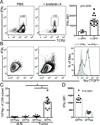Immunotherapy Expands and Maintains the Function of High-Affinity Tumor-Infiltrating CD8 T Cells In Situ
- PMID: 27503208
- PMCID: PMC5010950
- DOI: 10.4049/jimmunol.1502659
Immunotherapy Expands and Maintains the Function of High-Affinity Tumor-Infiltrating CD8 T Cells In Situ
Abstract
Cancer cells harbor high-affinity tumor-associated Ags capable of eliciting potent antitumor T cell responses, yet detecting these polyclonal T cells is challenging. Therefore, surrogate markers of T cell activation such as CD69, CD44, and programmed death-1 (PD-1) have been used. We report in this study that in mice, expression of activation markers including PD-1 is insufficient in the tumor microenvironment to identify tumor Ag-specific T cells. Using the Nur77GFP T cell affinity reporter mouse, we highlight that PD-1 expression can be induced independent of TCR ligation within the tumor. Given this, we characterized the utility of the Nur77GFP model system in elucidating mechanisms of action of immunotherapies independent of PD-1 expression. Coexpression of Nur77GFP and OX40 identifies a polyclonal population of high-affinity tumor-associated Ag-specific CD8(+) T cells, which produce more IFN-γ in situ than OX40 negative and doubles in quantity with anti-OX40 and anti-CTLA4 mAb therapy but not with anti-PD-1 or programmed death ligand-1. Moreover, expansion of these high-affinity CD8 T cells prolongs survival of tumor-bearing animals. Upon chronic stimulation in tumors and after adoptive cell therapy, CD8 TCR signaling and Nur77GFP induction is impaired, and tumors progress. However, this can be reversed and overall survival significantly enhanced after adoptive cell therapy with agonist OX40 immunotherapy. Therefore, we propose that OX40 agonist immunotherapy can maintain functional TCR signaling of chronically stimulated tumor-resident CD8 T cells, thereby increasing the frequency of cytotoxic, high-affinity, tumor-associated Ag-specific cells.
Copyright © 2016 by The American Association of Immunologists, Inc.
Figures







Similar articles
-
Agonist OX40 immunotherapy improves survival in glioma-bearing mice and is complementary with vaccination with irradiated GM-CSF-expressing tumor cells.Neuro Oncol. 2018 Jan 10;20(1):44-54. doi: 10.1093/neuonc/nox125. Neuro Oncol. 2018. PMID: 29016879 Free PMC article.
-
PD-1 blockade and OX40 triggering synergistically protects against tumor growth in a murine model of ovarian cancer.PLoS One. 2014 Feb 27;9(2):e89350. doi: 10.1371/journal.pone.0089350. eCollection 2014. PLoS One. 2014. PMID: 24586709 Free PMC article.
-
Timing of PD-1 Blockade Is Critical to Effective Combination Immunotherapy with Anti-OX40.Clin Cancer Res. 2017 Oct 15;23(20):6165-6177. doi: 10.1158/1078-0432.CCR-16-2677. Epub 2017 Aug 28. Clin Cancer Res. 2017. PMID: 28855348 Free PMC article.
-
Recent Advances in Targeting CD8 T-Cell Immunity for More Effective Cancer Immunotherapy.Front Immunol. 2018 Jan 22;9:14. doi: 10.3389/fimmu.2018.00014. eCollection 2018. Front Immunol. 2018. PMID: 29403496 Free PMC article. Review.
-
CD8+ cytotoxic T lymphocytes in cancer immunotherapy: A review.J Cell Physiol. 2019 Jun;234(6):8509-8521. doi: 10.1002/jcp.27782. Epub 2018 Nov 22. J Cell Physiol. 2019. PMID: 30520029 Review.
Cited by
-
The Dynamic Entropy of Tumor Immune Infiltrates: The Impact of Recirculation, Antigen-Specific Interactions, and Retention on T Cells in Tumors.Front Oncol. 2021 Apr 22;11:653625. doi: 10.3389/fonc.2021.653625. eCollection 2021. Front Oncol. 2021. PMID: 33968757 Free PMC article. Review.
-
Agonist OX40 immunotherapy improves survival in glioma-bearing mice and is complementary with vaccination with irradiated GM-CSF-expressing tumor cells.Neuro Oncol. 2018 Jan 10;20(1):44-54. doi: 10.1093/neuonc/nox125. Neuro Oncol. 2018. PMID: 29016879 Free PMC article.
-
New pathways in immune stimulation: targeting OX40.ESMO Open. 2020 Feb;5(1):e000573. doi: 10.1136/esmoopen-2019-000573. Epub 2020 Feb 9. ESMO Open. 2020. PMID: 32392177 Free PMC article.
-
A Phase I, Open-Label, Dose-Escalation Study of the OX40 Agonist Ivuxolimab in Patients with Locally Advanced or Metastatic Cancers.Clin Cancer Res. 2022 Jan 1;28(1):71-83. doi: 10.1158/1078-0432.CCR-21-0845. Epub 2021 Oct 6. Clin Cancer Res. 2022. PMID: 34615725 Free PMC article.
-
Androgen Receptor Inhibition Increases MHC Class I Expression and Improves Immune Response in Prostate Cancer.Cancer Discov. 2025 Mar 3;15(3):481-494. doi: 10.1158/2159-8290.CD-24-0559. Cancer Discov. 2025. PMID: 39652470 Free PMC article.
References
-
- Schumacher TN, Schreiber RD. Neoantigens in cancer immunotherapy. Science. 2015;348:69–74. - PubMed
-
- Gubin MM, Zhang X, Schuster H, Caron E, Ward JP, Noguchi T, Ivanova Y, Hundal J, Arthur CD, Krebber WJ, Mulder GE, Toebes M, Vesely MD, Lam SS, Korman AJ, Allison JP, Freeman GJ, Sharpe AH, Pearce EL, Schumacher TN, Aebersold R, Rammensee HG, Melief CJ, Mardis ER, Gillanders WE, Artyomov MN, Schreiber RD. Checkpoint blockade cancer immunotherapy targets tumour-specific mutant antigens. Nature. 2014;515:577–581. - PMC - PubMed
-
- Coulie PG, Lehmann F, Lethe B, Herman J, Lurquin C, Andrawiss M, Boon T. A mutated intron sequence codes for an antigenic peptide recognized by cytolytic T lymphocytes on a human melanoma. Proceedings of the National Academy of Sciences of the United States of America. 1995;92:7976–7980. - PMC - PubMed
Publication types
MeSH terms
Substances
Grants and funding
LinkOut - more resources
Full Text Sources
Other Literature Sources
Research Materials
Miscellaneous

